|
After two weeks on the ice we now has been picked up from Markham Fiord and transported to Eureka, a weather station just south of Ellesmere Island, which is operated by the Canadian Government.

|
|
Kenn Borek picking us up at Markham Fiord,
after a dramatic landing in the deep snow.
The pilots of Kenn Borek are really good!
|
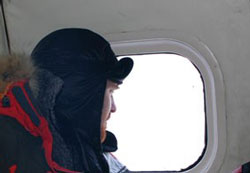
|
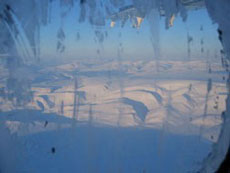
|
|
Looking out of the window in the Twin Otter airplane after the pick up on the ice.
I have no doubt we made the right decision.
|

|
|
Stepan outside the main entrance of the weather station in Eureka.
|
This year it is a lot more snow than normal and less wind than other years.
The result of this is that the snow won't be as hard and packed as if there were more wind.
This has not caused other problems for us than that our daily progress south has been a lot less than expected.
So we have not been able to walk more than around 8 kilometers on a good day.
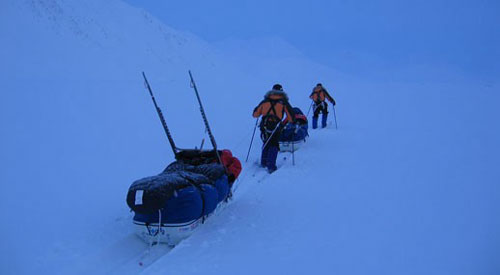
|
|
Oba "taking the lead" followed by Stepan.
|
The ice on Markham Fiord is not as rough as on the Artic Ocean.
In general the Fiord is very flat surrounded by high mountains.
The area is fantastic and we have had a lot of really nice and good views of the high artic.
The light changes during the day as the sun runs low over the horizon and mountain peaks.
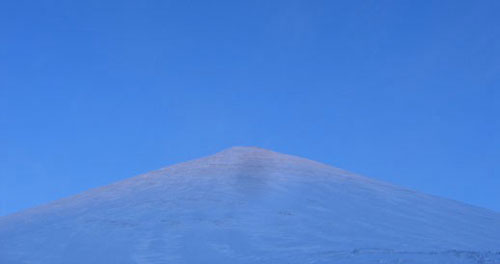
|
|
Symmetry
|
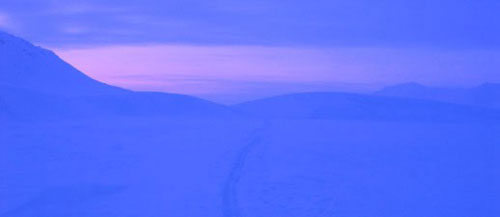
|
|
Light
|
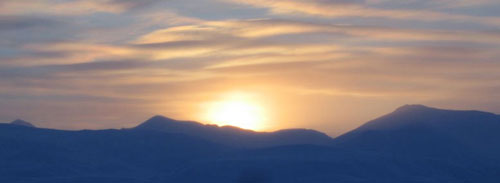
|
|
Fire in the sky
|
Most of the time we have had nice but cold weather with temperatures between - 35 and almost - 50 degrees Celsius.
In this period there has practically no wind, only a small wind chill from time to time.
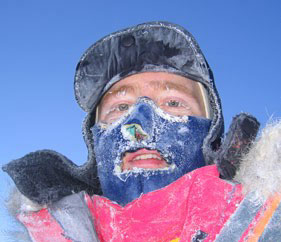
|
|
"The MASK"
|
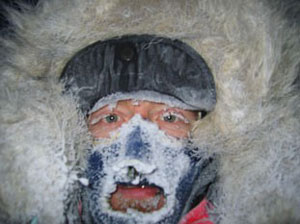
|
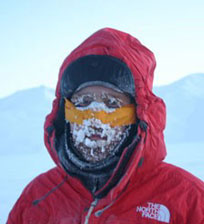
|
|
The use of a mask, as you can see, is very important to prevent frostbites in the face.
It doesn't take long before you look and feel like "iceman"!
|
We had a really warm period for a couple of days with temperatures up to -16 degrees Celsius and it felt like "summer"!
Daily routines are a lot more comfortable and all practical doings are a lot easier.
When the temperatures drops to -35 degrees Celsius or below, you must plan your moves a lot more in detail,
otherwise the cold will get to you and sometimes you are freezing so much that it hurts.
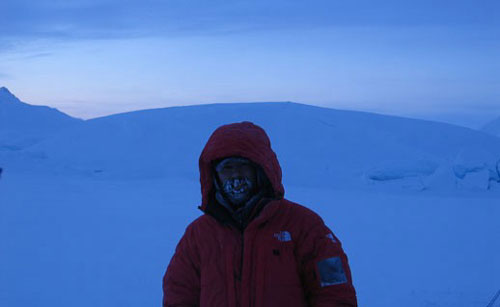
|
|
Our down jacket is very beloved and necessary part of our clothing,
but it gets filled up with ice if we use it when we are in activity.
Therefore we only use it in breaks and when we are preparing camp for the evening.
|
Constantly we are checking each other's face for frostbites. Sometimes you won't even notice it before it is too late and you have a white spot on your nose or at your chin.
Face, fingers and toes are always in danger, and sometimes it can take hours before you get really warm on your hands or feet's even if we are in activity.
It is a real thin balance between staying warm and being really cold.
If we are walking, we only need a couple of thin layers underneath our shell clothing,
so we don't get too warm and sweating too much.
The sweat stays in our clothes and freezes to ice, and as soon as we stop moving,
the cold comes and takes an iron grip on us.
When it's a lunch break, we can put on our down jackets which keep us warm for a period,
but when we "call it for the day",
it is important to remove the ice before putting on more clothes.
Otherwise the ice will melt, we get wet and cold,
and our thicker warmer clothing will be wet, freeze to ice,
and the heat capabilities will be reduced. This again will cause us more freezing.
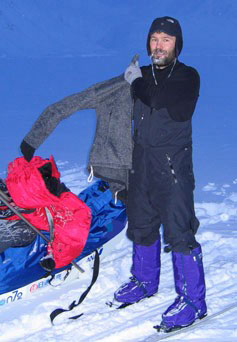
|
|
Stepan getting "dressed for a night out" in the warm period.
|
We finally came to the end of Markham Fiord after several days of marching in the deep powder snow.
The day of the arrival we had a total "white out" and wind from behind (NW).
In this area there are a lot of icebergs, broken rough ice, snow bridges and cracks.
This combined with very difficult light conditions and bad visibility it can be extremely dangerous to continue marching.
It is difficult to decide direction, orientate, and judge the surroundings.
For example, it is hard to tell if the small "hill" in front of you is an iceberg or the mountain hill and the end of the fiord you are looking for.
We had one bad experience that day. We had "parked" our sledges on the sea ice and started walking uphill.
The sight was "zero", but we could orientate from the wind direction, and we were trying to find a route up or around this hill.
I was walking as number two just a couple of meters behind the team member in front, when he suddenly "disappeared".
I carefully used my poles to check the ground in front of me,
to make sure that I wouldn't get a free fall and "disappear" too.
Luckily the team member only fell down a couple of meters and landed on soft powder snow,
so he was fine and the equipment as well.
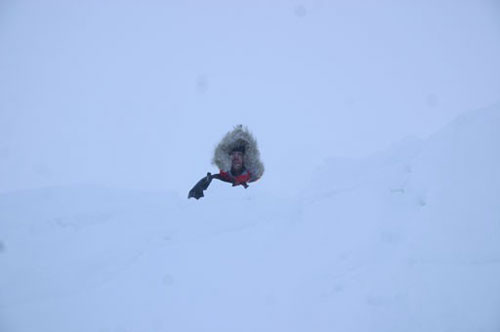
|
|
I am looking down and found the team member after his "free fall" off the iceberg.
|
But this was a true warning sign for the dangers that could change the situation for the members,
the team, and the whole expedition if we are not paying enough attention.
We must always remember that we can never challenge nature, only try to adapt to the environment we are in.
After carefully having checked the area, we decided to make camp and plan for the upcoming progress.
We were situated just at a ridge of the mountain area and according to the map we had two possible routes up and into the mountains.
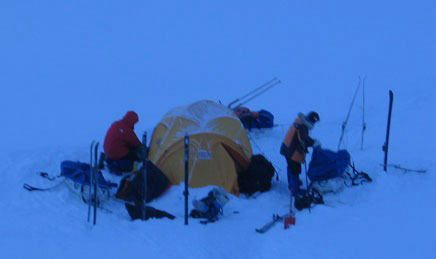
|
|
Stepan and Ohba preparing camp at a mountain ridge.
|
The following day we just took backpacks and necessary equipment to stay out and we started reconnaissance the possible routes we had picked from the map.
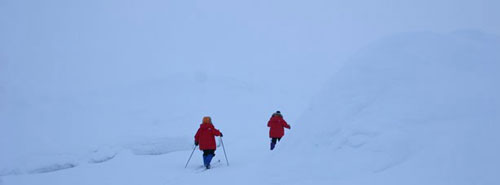
|
|
Stepan and Ohba on a recon trip; on both sides you can see icebergs.
|

|
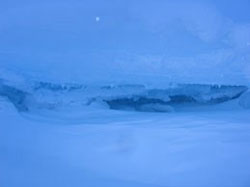
|
|
In this area there was a lot of broken ice, which can be very beautiful pieces of art,
but at the same time a warning of danger, so we must be careful.
|

|
|
The dark spots are open water covered with a thin layer of ice and new fallen snow; crushed ices are in the background.
|
Unfortunately all the possible ways we tried to come up to the mountain were blocked by the terrain. The expedition is not equipped or trained for technical mountain climbing and glacier walking.
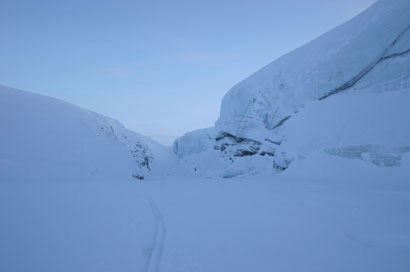
|
|
Between the glacier to the right and mountain hill to the left,
we found a way up the hill, and a couple of kilometers further into the "Highlands".
|
We had a lot of discussions of possible solutions for this situation.
If we had tried to continue our march into the mountain,
maybe it would have been possible to get a couple of kilometers up and into the area because it looked pretty good on the map.
In theory it should be possible, but in practice it was really dangerous.
And the area further in looked a lot more difficult according to the map.
That's where the real big problems would have shown up.
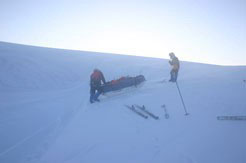
|
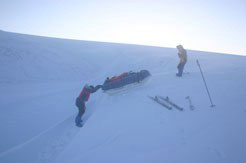
|

|
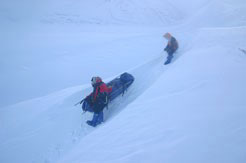
|
|
Places like this are not even shown on map. This is a ridge of snow and ice.
The altitude difference from top and bottom is aprox 30 to 40 meters.
Luckily we found a way down.
The other way around would have caused us a lot more trouble with a 100 kg sledge.
|
As long as everything goes well, there is no problem.
But as soon as we encounter a problematic situation,
we must be able to handle it ourselves, as we cannot calculate on getting assistance from a rescue team from outside.
For example if one of us falls into a crack in the glacier,
we need rescue equipment to help him out right away with no loss of time.
Because of the extreme temperature we would only have a couple of hours,
if we are lucky, to help him out before his life slowly would be ebbing away.
And in such a situation the person will be most likely very badly injured as well,
and then we would need advanced medical equipment for first aid and probably immediate transportation to hospital.
Help and assistance from outside can take between a few days to a week,
depending on the weather and how far up in the mountain area the incident has occurred.
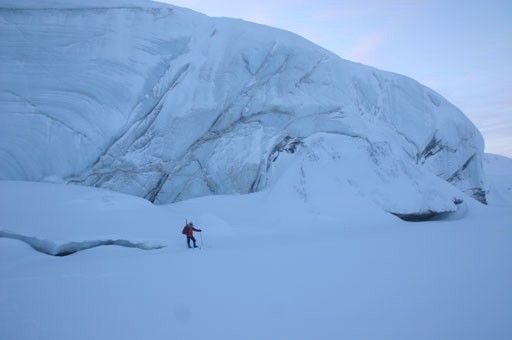
|
|
The dimensions are enormous; I am a pretty small man in a big world of ice and snow.
|

|
|
"Route hunting"
|
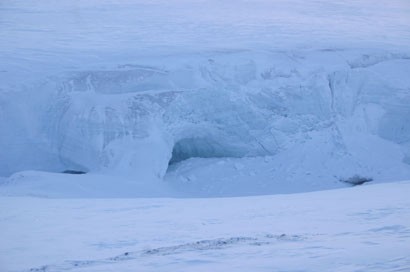
|
|
One slip and you get a "free ride", not with the underground but to the underground!
|
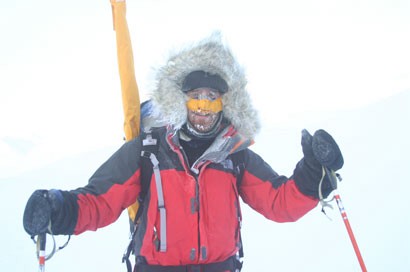
|
|
The route hunting was done without our sledges, only with back backs,
containing necessary supplies of gear and food.
Even with this light equipment we could not proceed very far into the high ground.
|
One thing is to climb up a mountain with the right equipment,
but another thing is to try to get down again, often times this is where many accidents happen.
Since we have prepared a ski expedition, not a technical climbing expedition,
we found it wiser to avoid these dangerous areas.
The potential routes through Ellesmere Island have plenty of steep hills,
crevasses, glaciers and river falls to mention some,
which would have caused a lot of troubles and dangerous situations for us.
If we had decided to continue, we would have needed different equipment and special gear for this purpose,
and we would most likely have used the whole available time to get to Eureka where we are now,
if everything went well. In addition we would have needed a lot of air supplies of food,
fuel, and equipment, which are very difficult in these areas.
The air distance from our pickup point to Eureka is around 500 kilometers,
out of our scheduled 4000 kilometers passage.
We would rather continue the travel than risking getting stuck in the mountain areas where there are small possibilities for re-supply.
All of us really want heart and soul this project to be a success,
so we reached a conclusion that the best possible solution is to be picked up,
transported to our next destination, and continue the travel form there.
We believe that this is the safest, wisest, and efficient solution; beside,
it causes only small changes, if any, to our schedule.
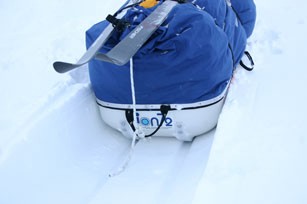
|
|
After the decision was made, we had to go back the same way we came for 2 days to find a landing spot where the snow conditions were not too deep.
|
There will always be calculated risks in expeditions like this.
Many things can happen and we must judge each situation as they occur.
It is impossible to predict all situations, but we need a good "plan A" and "plan B and C" in case that things turn out to be different from what we expected.
It is important to use common sense, stay calm, and think with head, not by emotion.
Some rules should be set up beforehand like deciding in what situation what actions to should be taken.
For instance when do we call for help and what does it take to stop the expedition.
Few things, especially not this expedition, are so important that it's worth risking our lives for.
Small changes in plan and continuing the expedition and maybe participating in other expeditions later is a lot better option than sacrificing everything,
including your life "the one and only",
which suddenly can be your last expedition and at the same time last breath of air...
The team is more motivated than ever to continue our journey south,
and we hope that the people and institutions related to the project,
our supporters and sponsors will understand the situation and continue to have faith in the project "Global EdVenture in Artic Canada" and believe in our judgment and expertise for the upcoming months of challenges in our fantastic journey in this beautiful country.
We so much want to share and cheer with you all!
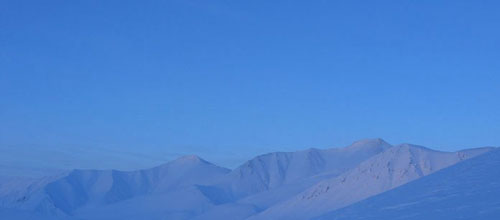
|
|
-Wonderland-
|
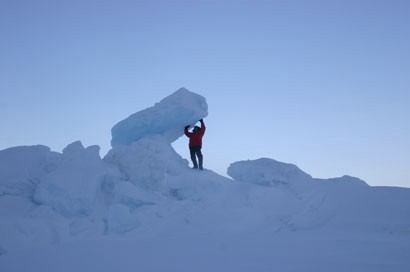
|
|
We know that it's always a lot of struggle....
|
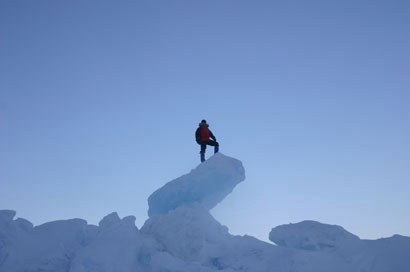
|
|
.....to "reach the top"
|
Håvard Svidal-Haugan
|



